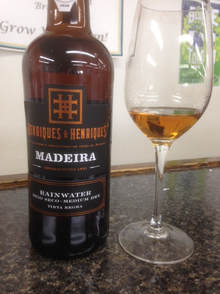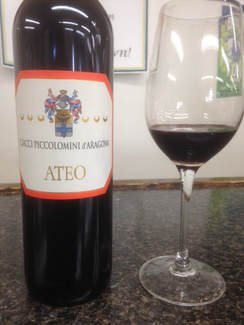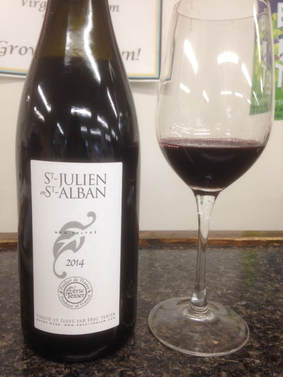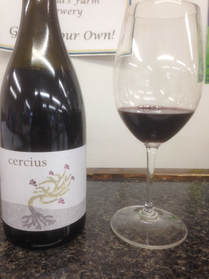 We don't venture into tasting out the fortified wines that often, usually because you have to catch people in the right mood to try what they consider a dessert wine. They are considered very singular in purpose, and most people don't think of having them unless those occasions absolutely slap them in the face to break them out. Sometimes we all need to be reminded, ourselves included, how broad and diverse these wines can be. Madeira in particular is both diverse in it's sweetness and immensely durable once it's opened thanks to the process used to make it (called 'estufagem'). The base wine is heated slowly by different methods to emulate the months of travel by boat centuries ago through the Tropics to its many worldwide locations. This helps create the nutty oxidized flavors that is so distinctive in Madeira, in many ways accelerating the aging process to a point where the finished product is almost immune to further damage from air exposure. The Rainwater style is the lightest of Madeira and can see a slow loss of subtlety over time, but that time is measured in months or years instead of days and weeks. Designated as 'Meio Seco', or medium dry, this shows a much drier side of the Rainwater designation, as the Henriques & Henriques is a very traditional family estate and builds their wines with an eye towards past styles. Lovely nose of toasted almonds backed with bright citrus and round pear notes, which only gets more complex and diverse in the days and weeks after it's opened, moving into caramels and zestier fruits. The palate is instantly both delicate and powerful, filling up all corners of your mouth with almonds, vanilla and citrus yet also maintaining acidity to allow the subtle leathery/tropical unertones to come through and the finish to linger for what feels like minutes without feeling cloying. This will re-establish your excitement for something a little more indulgent, but not priced to make you only bring it out for special occasions. You have a year or more to finish the bottle, so why rush yourself?
0 Comments
 There was a lot of controversy (at least for the Italians) years ago about wineries slipping grapes not allowed by the Cabernet Sauvignon and Merlot into their Brunello di Montalcino. The theory was that it would add some heft to the wine and garner higher scores from high profile wine reviewers, eventually bringing in more fame and higher prices for their wines. Over time much of the problem has been dealt with, and one of the happier accidents to come from it has been the spotlight brought to some of the Tuscan appellations that actually allow and encourage those grapes to be used. The Sant'Antimo D.O.C. essentially surrounds the borders of Brunello along with some vineyard areas on the outskirts, and with well regarded wineries like Ciacci Piccolomini using the name more frequently on tasty wines like this it is sure to become a more household name. Built from a higher percentage of Merlot than Cabernet Sauvignon, the wine sports an inky purple color and initial aromas of classic Bordeaux wines like dark currants and plums. As it opens up the aromas start to give off some of the dried Tuscan earth that comes through in the better Chiantis and Rossos/Brunellos, showing the sense of place above the grapes used. On the palate the fruit is fairly plush and modern, not a lot of oak coming through and loaded with hearty flavors and just a touch of savory Tuscan herbs to the finish. This is a wine that both Italian fans and those just learning the ropes will enjoy, perfect with hearty meats and cold weather dishes.  The name Eric Texier has been an important name in the world of wine making for about two decades now, even if you have never heard of him. Eric jumped into the industry without owning any vineyards or having any familial connections, choosing to lease and source vineyards over the cost of buying parcels. His strict traditional methods applied to his vineyards and wine making earned a reputation that flew in the face of the trends of the time, which either brought great praise or scorn depending on where you fell on the flavor scale. Very polarizing, but the wines have encouraged similar risks being taken in many other parts of the world, and the leasing and pursuit of forgotten parcels of vines has become the mantra for a new wave of Californian wine labels that have helped breathe new life into the industry. One of the more controversial elements of the Texier methods- primarily Biodynamic, with his own emphasis on certain parts more than others-is the desire to use little to no sulfur. While it can affect the stability of the wine once bottled (creating consistency issues from bottle to bottle, especially when not stored well), there is no doubt that it allows the wine to have a very singular flavor. The vineyard for this Cotes du Rhone sits in the 10-15 mile void between the southern end of the Northern Rhone and the northern end of the Southern Rhone. Taking more inspiration from the Northern Rhone on this, the wine is 100% Syrah and drinks with the savoriness and high toned fruit expression of a fine St Joseph or Cornas. Deep in color, the aromatics are surprisingly elegant and perfumed with lots of violets and red skinned fruits, almost hinting at citrus. The use of whole clusters gives the palate an almost Burgundian combination of silky tannins and earthy dryness. a very traditional texture that shows less of the sappy, extracted fruit and more earthy tones. The real ride comes as the wine sits open for an extended period of time, and the red fruits start to emerge and bring a constantly changing array of blue and black fruits into the picture. Patience is necessary for this wine, either over the course of an evening or in a decently controlled storage space, but fans of the style will be heroically rewarded.  When the weather gets as cold as it is supposed to over the next few days, most people aren't looking for a wine that is too intellectual or contemplative. Rich, flavorful, and immediately satisfying is the name of the game if you are going to brave the single digits to join us in our constantly 'balmy' 55-60 degree store. This is just such a wine, one of the many remarkable producers from importer Eric Solomon's portfolio of French and Spanish wineries that just can't help but make tasty wines. The combination here of older Grenache and Syrah parcels along with raising the wine in cement tanks provides a luscious, texture and immediately pleasing wine without loosing the underlying subtle character that gives the wine a sense of place. Big red and black fruits burst from the glass immediately from the pour, almost hinting at sweetness initially but quickly developing notes of anise, herbs and a savory spice rub. In the mouth the texture is immensely unctuous with lots of the dark cherry and currant fruit coating the palate. Fans of an Old School style of Cotes du Rhone may miss the gamier tones on the palate from using Carignan or Cinsault in the blend, or the tannins and extra acidity from Mourvedre, Different strokes for different folks, and part of what makes the Rhone so much fun and constantly enjoyable to explore. This is a dream wine for 'fruit first' lovers, and a must for helping thaw your senses while braving the harsh season ahead. |
The Best of the Best.We offering free tastings on these wines in the store every Thursday and Friday, and a 10% discount off the retail price through the duration of the day. Come on by and give them a try! Archives
July 2024
Categories |
Location |
|

 RSS Feed
RSS Feed